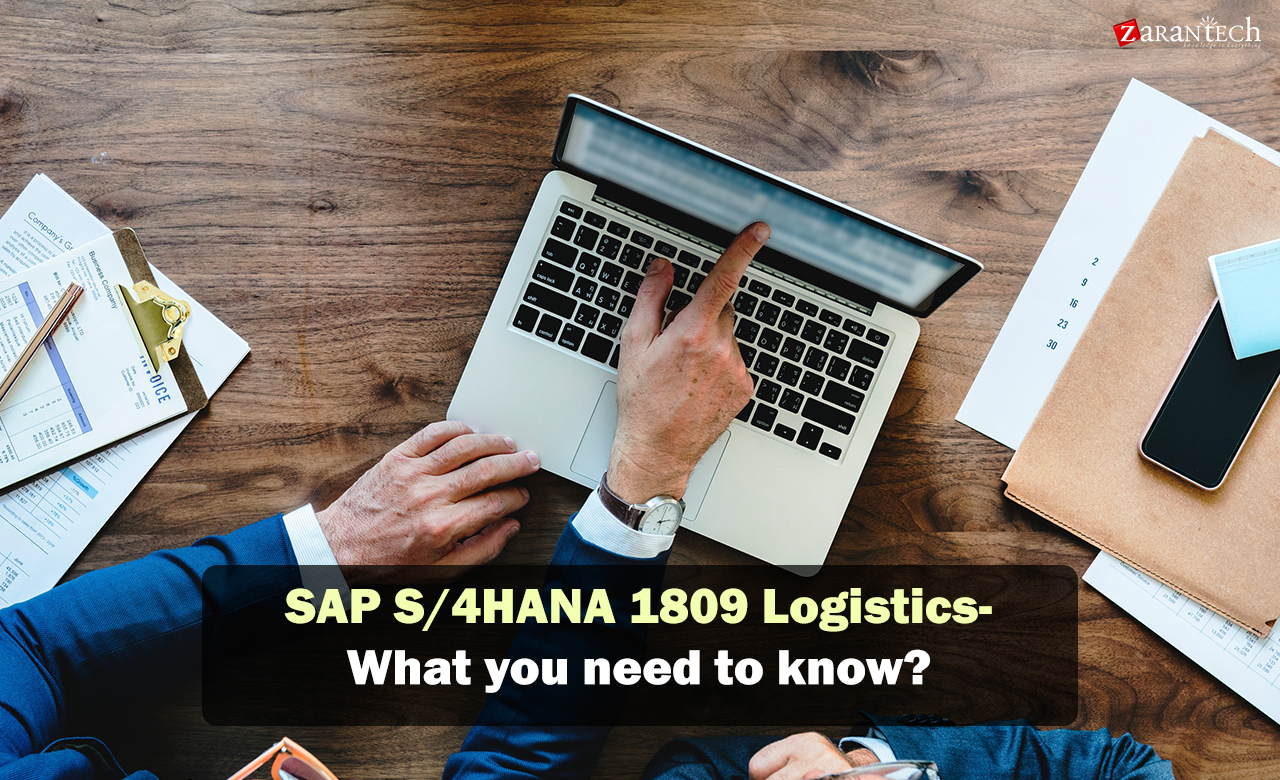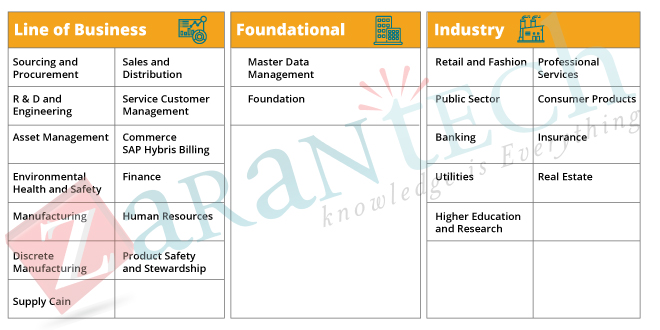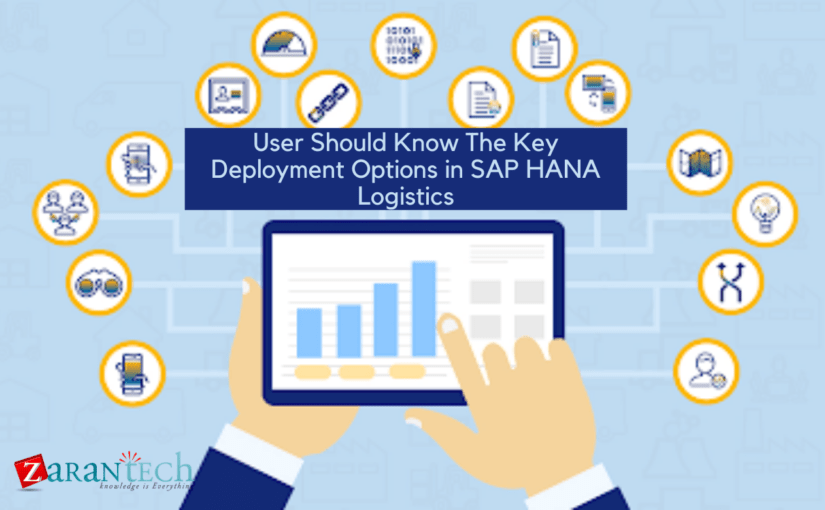SAP S/4HANA 1809 Logistics- What you need to know?
Category: SAP S/4HANA Logistics Posted:Apr 01, 2019 By: Ashley Morrison
Logistics plays a crucial role in the supply chain of the company. A good logistics system is essential for the optimum utilization of goods and services to meet customer demand. Meeting customer expectations means getting more business. Enterprise success depends on how well the company manages the flow of products and services into and out of business. SAP S/4HANA 1809 logistics will give you a competitive edge in meeting customer expectations and thereby meeting customer demands. It offers solutions to a wide range of business. The lines of business include Asset Management, Commerce, Finance, Manufacturing, Manufacturing for production, R&D/ Engineering, Sales, Sourcing and Procurement, Supply Chain, Integration, Cross Components, etc.

Let’s us learn about some of the innovation in SAP S/4HANA 1809 logistics under different lines of business.
Checkout the Article- A Completes Guide of SAP Simple Logistics
Asset Management
Solution area Maintenance Execution
There is a new title Enterprise Asset Management Part 12 under Asset Management. It will be beneficial for Maintenance operations. It enables the service provider to use several enhancements for maintenance plans and maintenance orders for the plant.
There is a Maintenance Order: Generate Object List Entries. It is a powerful tool for generating object list entries. These features enable maintenance order on SAP Web UI for plant maintenance. It offers you various options like technical objects, maintenance notifications, and identification of objects with a combination of material and serial numbers.
There is a new option known as Maintenance Order. It gives you the opportunity of new fields in mass change. The product features offer an enhanced number of areas while making maintenance in the order list of the SAP GUI transaction IW38. The process-specific fields are beneficial for order header and particular customer details.
There is a new title Maintenance Order: Additional Long Texts. The features enable them to enter various long texts for operations and components while processing maintenance orders. It also creates a purchase requisition and copies notes from maintenance order to purchase requisition.
Solution area Maintenance Planning and Scheduling:
The Classification of Maintenance Plans offers you a feature to classify maintenance plans. It helps you to organize plants based on similar properties.
Solution area Plant Maintenance:
There is also Core Data Services which is meant for BW Extraction.
Now you can easily integrate with Asset Intelligence Network with Enterprise Asset Management Product. It enables you to access the AIN platform from EAM and integrate technical objects with details in AIN.
Cross Applications:
Under this heading, a new title Consent Administration is included. It assigns Consent Records as Consent ID. It enables you to manage data ageing object to manage outdated information. There is a new report option Recalculate Consent Statuses allows you to keep all statuses and relevant for consent record.
There are changes in the title Maintain Business Operations. It helps in maintaining Supply Regions in Purchasing Tab with Maintain Business Partner app. The geographical zones are charted as the regional supply chains.
There is a new change in the title Manage Product Master Data. A new feature Subscription Product features are added. It enables one to create a Subscription product.
Finance
The Data Aging Tool for Log of Tax Services enables you to manage outdated information and saves more memory by moving a set of data.
There is another option known as Archiving of Log of Tax Service Calculation Operation. It facilitates archiving tax calculation.
The GSTR-1 Report has been included to offer various additional features like the generation of GSTR-1 report after submitting tax to the government. Multiple options are available which enable you to choose appropriate condition type for different taxes. You can map tax codes to specific GST codes. You can match the unit quantity code with specific standard SAP unit of measurement. There is a facility to map state codes to the state code internally.
There are GSTR 3B features to generate GSTR3-B report for the generation of tax to be sent to the tax authorities. It helps you to identify the condition type for different taxes. It also gives you the features of Tax Box Structure Settings to maintain various tax groups.
Accounting Enhancements for Banking:
The feature of Accounting Enhancements for banking enables to manage FX currency position in their original currency. It offers features like currency transformation which allows transforming foreign currencies on PIP/WIP accounts and FX transaction into functional currency. There is another option known as vendor/customer items revaluation. It enables to post adjustments in the amount for functional currency.
Accounting View of Logistics Information:
It helps to replicate pricing documents for sales order and supplies invoice from the source system to the Central Finance System.
Initial Load Performance Improvements:
The features enable to improve performance and handling of the initial load.
EC-PCA Postings Replication and Deletion Enhancements:
The above features help to set the start of the fiscal year and start period for an ongoing period of EC-PCA of internal postings easily. There is a facility for running a deletion report in Central Finance. This feature enables to clear all data generated during initial load phase.
Handling of Reconciliation Accounts as per Company Code:
The features help make settings for each company code and define how the system handles reconciliation accounts.
Historical Open Items- Ensuring Payments and Clearing Take place in the Source system
The feature allows setting payment blocks for historical opens settings in the Central Finance System. The historical open items referred to the open items created before Central Payment Activation and duplicated in Central Finance.
Enhancement for Down Payment and Integration with Sales and Distribution:
It offers multiple features like creating down payment by navigating from the reference field in the sources to the Central Finance System or use Fiori Apps in the SD down payment system.
FI initial load from SAP S/4HANA Source Systems:
It helps to load faster from the initial load of entries from SAP S/4HANA source system to a Central Finance System. The replication and deletion of data can be done more quickly because of this feature.
Checkout the Article- User Should Know The Key Deployment Options in SAP S/4HANA Logistics
Insurance:
Improvements for Importing Test Structures:
The upgrades for importing test structures help to filter contents and text field in the wizard for introducing test structures. The features allow for alphabetical sorting by clicking various column headers.
Object extensions for structures:
The object extensions for structures help extend arrangements. It enables the customer to deliver standard content as per their needs.
Analysis of Financial Data and Operational Data:
It is one of the latest features added for using Core Data Services views in Claim Management to analyze financial and operational data.
Data Models for Informational Retrieval Framework:
There are preconfigured data models for Informational Retrieval Framework. The following tool helps to retrieve personal data.
Change list for PSV Import:
It includes all the changed, added and deleted content object and packages since the last build. The added features reduce the time required to transfer the amount of data to move to the SAP system.
POTATO: Support for Workspace File Restrictions:
The features enable one to use File from the Workspace in POTATO in addition to the constraint type PMQ Object.
Integration with SAP Hybris Commerce:
The feature helps one to connect Claim Management to the customer portal. The benefit of this feature is to create a notice of loss or to display data of current claims.
Manufacturing:
Manage Shop Floor Routings:
The feature enables to create and manage shop floor routines. You can use multiple floor routines and new functions that are available for maintaining shop floor routines.
Manage Standard Text:
The features assist you in creating standard texts in multiple languages. The standard works are used for the creation of work floor instructions in the shop floor routines. The SAP GUI versions of shop floor routing are used in creating work instructions in multiple languages.
My Work Queue:
The feature allows searching and viewing the operation activities going on in the current month. The app display operation activities in the initial, in the process and paused phase. The app allows filtering the work and proceeding to execute the chosen action.
Status and Action Schema Application:
The steps to create status and action schema is simplified to create Status and Action Schema so that people can easily copy default SAS and use it to suit the requirements.
Operate:
The app assists to perform retroactive processing. The setting of operation activity to retroactive processing changes the status to show it is being worked upon.
Data Aging for Demand-Driven Replenishment:
This feature assists in getting more area by moving data aging objects to a cold area. There is Product Buffer Level Management data ageing object which stores buffer proposal information for up to 180 days and the Demand Driven Time-Dependent Stock Level Data Aging Object store information about daily stock for the next 365 days.
PIRs in Average Daily Usage:
The facility helps you to view Planned Independent Requirement in the future in both the chart and table view.
Manage Production Order for Process Orders for MRP Controllers:
The above features help you to edit, delete or convert MRP elements on the stock tab using the action available for each MRP element in the Action columns. There is a facility of Manage Work Centre Capacity app from the milestones tab in the Utilization column on the tab.
Go through our SAP S/4HANA Simple Logistics Interview Questions to crack the Interviews.
Conclusion
Many facilities are available in the SAP S/4HANA 1809 Logistics. We have discussed mainly the modification done in Asset Management, Accounting, Finance, and Manufacturing. This new modification gives a competitive advantage over the enterprise. It enables the organization to leverage its potential to its full capabilities. It takes care of routine work. SAP S/4HANA 1809 Logistics is a specially designed enterprise suite for the global organization of today.
I hope that by now you have had an overview of SAP S/4 HANA Logistics. Before you enroll in ZaranTech’s certification course on SAP S/4 HANA Logistics , do check out the S4 HANA Logistics demo:





 99999999 (Toll Free)
99999999 (Toll Free)  +91 9999999
+91 9999999